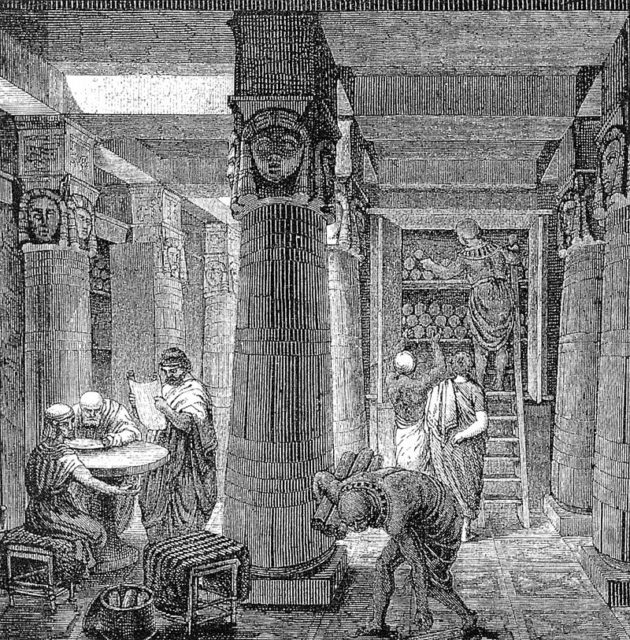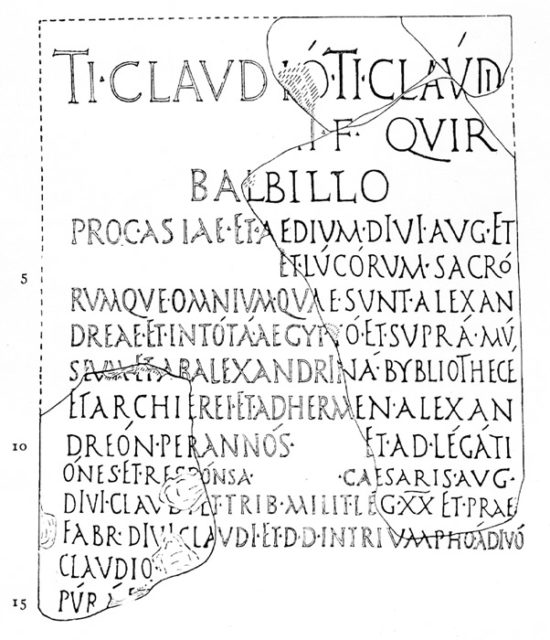The Royal Library of Alexandria in Egypt was one of the largest and most important centers of learning and discovery in the ancient world. Its holdings were valuable resources to the Pharaoh and allowed him to show off the wealth of Egypt to foreign powers. The library was created by Demetrius of Phaleron, a former Athenian politician and adviser to King Ptolemy I, and Soter, a Macedonian nobleman and one of the successor kings of Alexander the Great.
Dedicated to the Muses, the nine daughters of Zeus and Mnemosyne who were protectors of the arts, it thrived under the sponsorship of the Ptolemaic dynasty. Constructed in 280 BC, it not only managed an extensive collection of books and scrolls, but it also included lecture halls, classrooms, banquet halls, and extensive gardens. It was surrounded by Greek columns that still stand today, and featured a covered walkway and rooms for group dining. The thirteen lecture halls had a capacity of about 380 people each. One chamber contained shelves of papyrus scrolls with an inscription above the shelves reading, “The place of the cure of the soul.”

The library was just one part of the Musaeum of Alexandria and was primarily assigned to learning and research. Additionally, the Musaeum accommodated the study of astronomy, anatomy, and zoology, and even had a zoo of exotic animals. The classical philosophers who studied and experimented at the Musaeum included prominent intellectuals such as Euclid, Archimedes, Ptolemy, Aedesia, Pappus, and Aristarchus of Samos.
There’s been little opportunity to determine the collection’s size with confidence. Papyrus scrolls constituted much of the collection and books started to be popular only after around the 4th century. Just a few chapters could take up several scrolls and the material reproduced into books was part of the editorial work. It is believed King Ptolemy II Philadelphus (309–246 B.C.) set as a goal for the library that 500,000 scrolls would be copied. At its pinnacle, the library held, according to estimates, as many as 400,000 scrolls – a collection that required immense storage space.
The library acquired some of its collection by the painstaking copying of original scrolls. Unfortunately, copying eventually leads to errors and the libraries insisted upon caring for the originals. According to Galen of Pergamon, a prominent Greek physician, surgeon, and philosopher in the Roman Empire, books found on incoming ships were taken to the library and listed as “books of the ships.” After official scribes had copied them, the originals were kept in the library, and the copies were given back to the owners. Verified copies made for scholars, royalty, and wealthy patrons provided income for the library. In turn, the library attracted international scholars with travel, lodging, and stipends for their families.

Galen wrote that Ptolemy III once asked the Athenians for permission to borrow some original scripts, most notably those of Euripides, Sophocles, and Aeschylus. The Athenians asked for a deposit of the large sum of fifteen talents (1,000 pounds) of a precious metal. Ptolemy III paid the deposit, but he kept the original scripts and gave the Athenians copies.
The editors at the Library of Alexandria were known for their work on Homeric texts. Many famous editors held the title of head librarian, including Zenodotus, Apollonius of Rhodes, Eratosthenes, Aristophanes of Byzantium, and Aristarchus of Samothrace. Needing to protect the scrolls and improve the patronage, Athenian scholars began looking for a more secure place for the library in the early 2nd century BC. In 145 BC Ptolemy VIII removed all foreign scholars from Alexandria.
Around 48 BC, Julius Caesar is said to have seized the city and set fire to enemy ships in the harbor. The fire spread and destroyed the buildings closest to the harbor, including the library. The library remained viable to a degree until its contents were completely lost when Emperor Aurelian (270–275 AD) captured the city. During the battle, the area of the city in which the main library was located was ruined.

Pagan worship was outlawed by an edict of Emperor Theodosius I in 391 AD, and Patriarch Theophilus closed the temples of Alexandria. Socrates describes how all pagan temples in Alexandria were destroyed, including the Serapeum, which at one time housed a part of the Great Library.
After the library had been destroyed, scholars used a “daughter library” in the Serapeum temple in another part of the city. According to Socrates, Pope Theophilus of the Orthodox Christian church destroyed the Serapeum in 391 AD, but it is unknown if it contained any of the significant documents from the main library.
